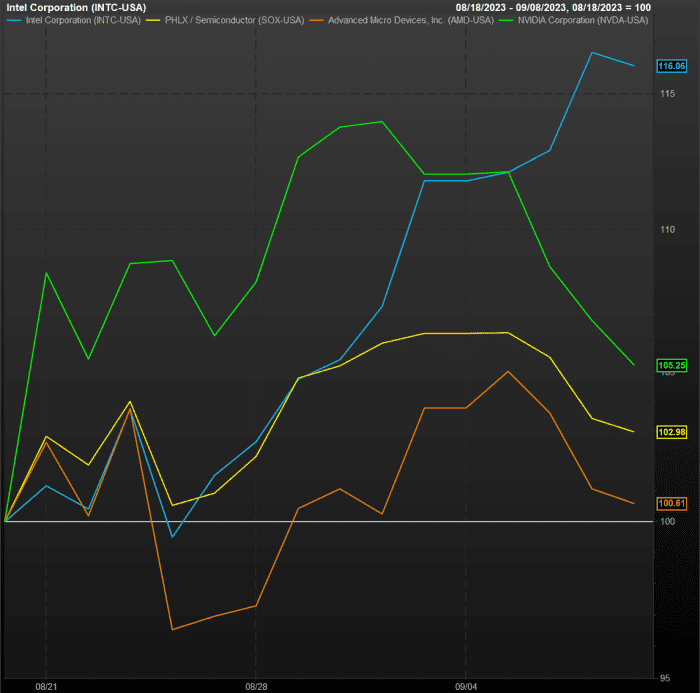This post was originally published on this site
Intel Corp. shares finished lower Friday, snapping their longest winning streak in nearly three years, but at least one analyst wondered why more investors aren’t bullish on the stock given the chance a trade war between the U.S. and China could disrupt semiconductor “fab” operations in Asia, leaving Intel in a plum production position domestically.
Intel
INTC,
shares closed down 0.5% at $38.01 Friday, snapping a nine-day winning streak that produced a 17.2% gain. For the holiday-shortened week, however, shares finished up 3.8%, while the PHLX Semiconductor Index
SOX
finished the week down 3.2%.
Given the nine-day winning streak, Mizuho analyst Jordan Klein asked in a note earlier Friday: “How long can long-only managers continue to underweight or avoid INTC?”
Klein reasoned that Intel, while bruised and battered over the past few years, is still a $160-billion-market-cap stock that’s not only up more than 40% year to date, but has outperformed Nvidia Corp.’s
NVDA,
stock by more than 1,000 basis points over the past three weeks.
The Mizuho analyst also noted that Intel’s 3.2% gain on Thursday versus the PHLX Semiconductor Index’s 2% decline came as China increasingly targets U.S. companies like Apple Inc.
AAPL,
Read: Here’s why Wall Street may be overreacting about Apple’s China’s challenges

FactSet
Intel “owning the biggest U.S. semi fab could be increasingly valuable,” Klein said, also pointing out that at least one competitor, GlobalFoundries Inc.
GFS,
rose 1.3% Thursday. On Friday, GlobalFoundries shares finished up 2.6%.
Read: Intel’s stock logs longest winning streak in nearly 3 years
Like chip makers Texas Instruments Inc.
TXN,
and Micron Technology Inc.
MU,
Intel operates fabrication facilities known as “fabs” that etch designs of nanometer-sized transistors onto silicon disks that become finished semiconductors. Many chip makers, however, like Advanced Micro Devices Inc.
AMD,
and Nvidia, as well as companies like Apple that design their own chips, are “fabless,” meaning they rely on third-party fabs like Taiwan Semiconductor Manufacturing Co.
TSM,
SK Hynix Inc.
000660,
and Samsung Electronics Co.
005930,
to make the physical chips.
While TSMC has moved to open fabs in the U.S., the bulk of its facilities are in Taiwan and China. As evidenced during the COVID pandemic and related China shutdowns, any disruption of the semiconductor supply chain in Asia can have far-reaching consequences for an industry that relies on chips. In fact, Intel recently moved into the third-party fab business with Intel Foundry Services, but the business arm has yet to name a high-profile customer.
Read from December: Apple, AMD confirm they’re among TSMC’s first Arizona customers, while Intel preps for return to cutting edge in 2023
Klein admitted that Intel’s management and stock performance “still has a long road ahead to fully convince a highly skeptical [long-only] investor community, but I hear more and more hedge funds buying into this rally on view it’s a safe place to hide into Sept. [third quarter] results,” Klein said, especially as a “perceived ‘domestic semi winner’ if U.S.-China trade war intensifies.”
Of the 44 analysts who cover Intel, nine have buy ratings, 28 have hold ratings, and seven have sell ratings, along with an average price target of $36.91.
Read also: Intel gets surprise data-center tailwind as it looks toward ‘meaningful’ AI growth next year

